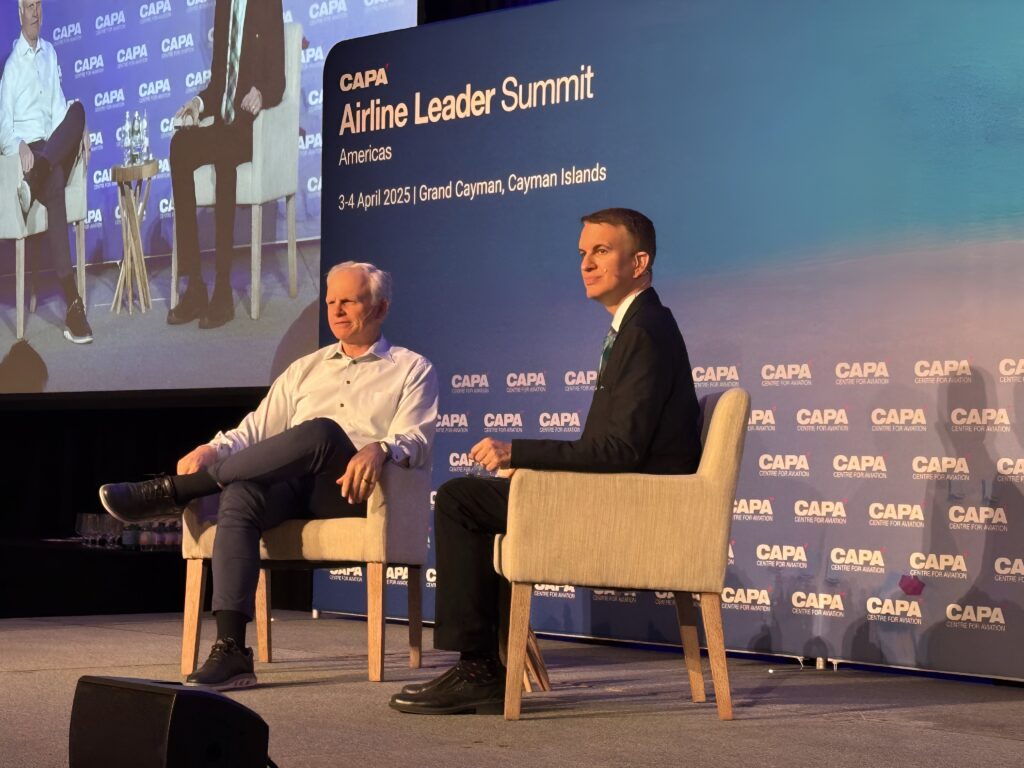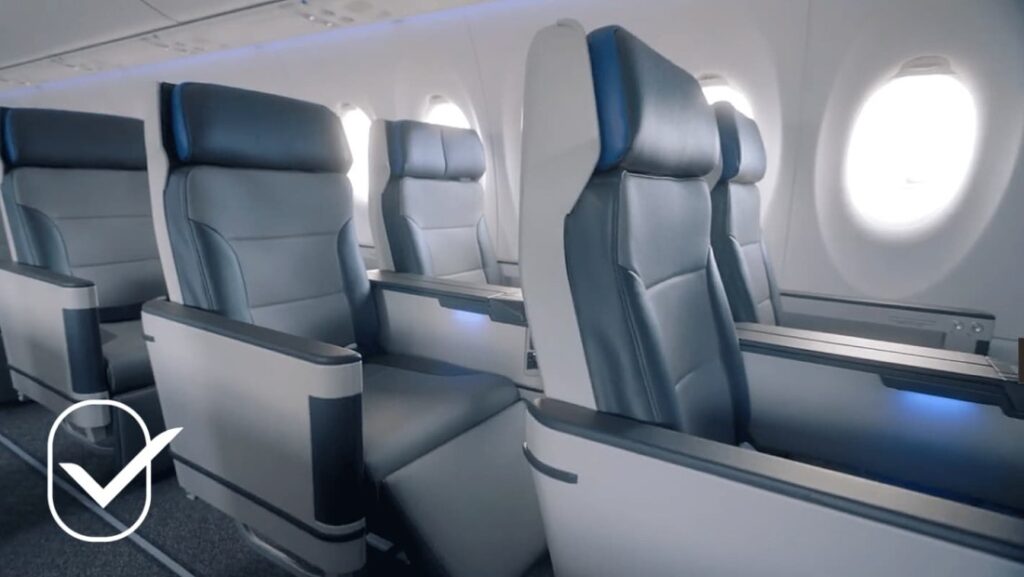Breeze Airways CEO David Neeleman Opens CAPA Summit with Bold Vision for Passenger-Centric, Tech-Driven Airline Growth
Share

Breeze Airways Founder and Chief Executive Officer David Neeleman opened the CAPA Airline Leader Summit in Grand Cayman on April 3 with a candid and wide-ranging conversation with APEX GCEO Dr. Joe Leader. As the first keynote airline discussion of the summit, the session set the tone for a day focused on innovation, strategic transformation, and reshaping the airline business around the needs of travelers.
Over 30 minutes, Neeleman mapped out the founding philosophy and future path of Breeze Airways, emphasizing underserved markets, digitally native operations, and elevated passenger experience without high costs. Drawing on a legacy of reshaping airline models with JetBlue, Azul, WestJet, and Morris Air, Neeleman outlined how Breeze leverages lessons from his past ventures to build a nimble, responsive airline designed for the modern traveler.
“I’ve spent my whole career trying to make flying better for people who don’t live in the biggest cities,” Neeleman said. “Breeze finally lets us connect those dots with nonstop service, great aircraft, and a simple, affordable experience.”
Underserved Markets, Direct Flights, Real Savings
Neeleman described Breeze’s network strategy as purpose-built for a traveler segment often ignored by both legacy and low-cost carriers — those flying between midsize cities.
“From day one, we knew we didn’t want to be just another airline trying to squeeze into the same crowded markets,” he said. “We wanted to go where the need existed, where people had been ignored — cities where the only options involved long drives to bigger airports or hours of connecting flights through hubs.”
The airline connects point-to-point city pairs such as Charleston to Akron or Provo to San Bernardino, providing nonstop service that shaves hours off traditional itineraries. Breeze uses advanced data modeling to identify viable routes where incumbents see too little demand for their existing models.
“We wanted to go where the need existed,” Neeleman said. “Cities where people had been ignored.”Passengers benefit from simplified logistics and reduced travel stress, with less time spent in congested terminals or navigating long layovers.
Fleet Choices That Prioritize Comfort and Economics
Dr. Leader turned the discussion toward Breeze’s fleet strategy, prompting Neeleman to highlight the Airbus A220 as the carrier’s growth engine. “The A220 allows us to fly coast-to-coast efficiently with a better onboard experience than any other aircraft in its class,” Neeleman said. “It’s quiet, fuel-efficient, and passengers love the cabin layout.”
The Airbus A220 features a 2-3 seating layout in economy, eliminating middle seats entirely on one side and offering a more spacious, widebody-style experience in a single-aisle aircraft. Breeze outfits its A220s with 36 “Ascent” seats in a two-by-two configuration at the front of the cabin, providing extra legroom, in-seat power, and dedicated overhead bins. Remarkably, this premium layout reduces capacity by only one seat per row compared to the standard configuration — a trade-off that allows Breeze to offer a first-class-style experience within a low-cost model. These seats form the centerpiece of the Nicest fare bundle, creating an accessible upgrade path for value-driven travelers. The airline highlights on their website the many accolades their seats have won including APEX Best Seats in North America in 2024.

“We’re getting 16 new A220s this year,” he added. “Every time we put one into service, we expand the map of where we can fly nonstop.”With transcontinental capability, the A220 supports Breeze’s expansion into longer-haul domestic markets while maintaining a focus on lower unit costs and a more comfortable passenger experience.
Passenger Experience Designed for Control and Simplicity
Dr. Leader asked how Breeze delivers a modern customer experience while maintaining low overhead. Neeleman pointed to the airline’s clean-sheet approach, built entirely on mobile-first infrastructure.“We built the airline around the idea that your phone is your boarding pass, your check-in agent, and your help desk,” Neeleman explained. “We didn’t want long lines, printed itineraries, or call center wait times.
Breeze’s app serves as the primary interface for booking, check-in, flight changes, and customer service. By eliminating reliance on traditional contact centers and printed processes, the airline focuses its staffing and support on the most impactful passenger moments.“ Our systems anticipate problems before customers even know something’s wrong,” he said. “We use automation to solve what machines can handle, so our people can focus where it matters.”
Breeze also prioritized high-speed inflight connectivity through Viasat across its Airbus A220 fleet, ensuring that passengers remain connected from gate to gate. “Inflight connectivity makes a big difference,” Neeleman said. “Whether people want to work, stream, or stay in touch, we knew we had to offer that from the start.”
Tailored Fare Options with Clear Value
Breeze’s fare structure — divided into “Nice,” “Nicer,” and “Nicest” — allows travelers to select the level of flexibility and comfort they prefer. The Nicest tier includes priority boarding, checked bags, and access to Ascent seating on the Airbus A220. “We’ve had travelers tell us they’ve never flown in a premium seat before,” Neeleman noted. “For them, it’s a whole new experience — more comfort, less stress, and still affordable.”

Dr. Leader highlighted the distinctiveness of providing a first-class-style product within a low-cost framework. Neeleman responded that simplicity and passenger choice guided every decision around Breeze’s fare bundles and onboard offerings.
Scalable Growth Without Overextension
On operations, Neeleman emphasized that Breeze has intentionally scaled at a sustainable pace to protect reliability and employee morale. “We’ve grown thoughtfully,” he said. “We’re not trying to do too much too fast, and that’s helped us avoid some of the major disruptions others have faced.”
When asked about workforce retention and growth. Neeleman responded that Breeze created a culture centered on transparency, communication, and a shared sense of mission.“Our people know they’re part of something new and meaningful,” he said. “That sense of ownership makes a huge difference.”
Vision 2030: Measured Expansion and Market Gaps Still Unfilled
Looking ahead, Dr. Leader asked where Breeze would stand by the end of the decade. Neeleman laid out a clear trajectory rooted in the same market logic that inspired the airline’s launch. “By 2030, we expect to be serving over 150 cities,” he said. “There are still so many places in the U.S. that don’t have nonstop service — and that’s just the beginning.”
Towards the close of the session, Neeleman also highlighted upcoming flight connections between Breeze and Azul, set to begin this summer. The partnership will enable travelers to book itineraries that link Breeze’s U.S. domestic routes with Azul’s extensive network in Brazil, offering more seamless travel between secondary cities in both countries. “It’s a natural fit,” Neeleman said. “We’re connecting the dots between two airlines that share the same DNA — great service, great people, and nonstop routes where others don’t fly.”
While specific international plans were not discussed, Neeleman’s focus remained on expanding Breeze’s domestic footprint to meet latent demand, with the Airbus A220 playing a central role. “We’ve built Breeze to remove the hassles, reduce the connections, and let people fly the way they’ve always wanted to,” Neeleman said. “That mission won’t change — it will only grow.”


